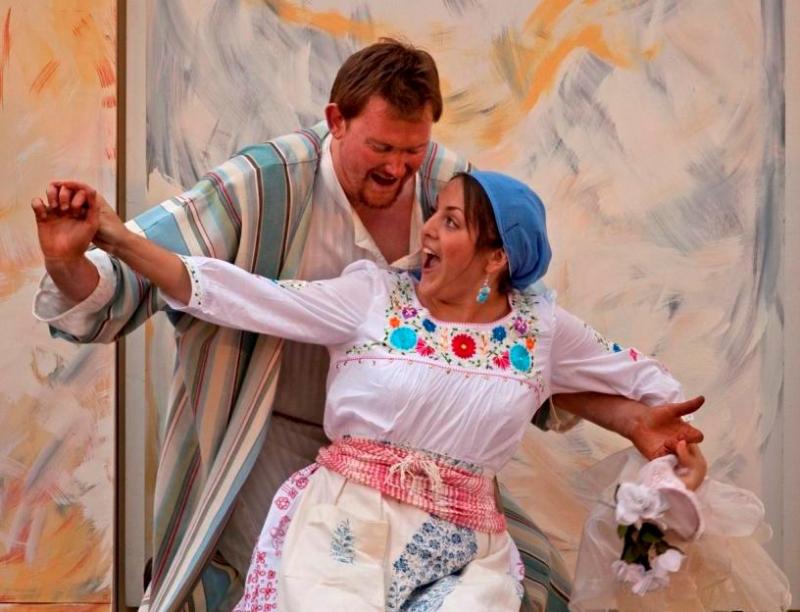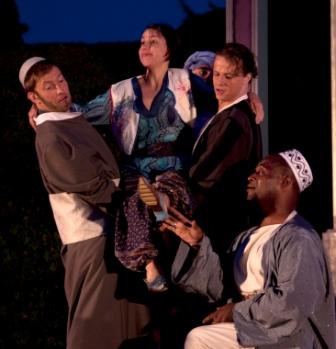The Marriage of Figaro, Buxton Festival | reviews, news & interviews
The Marriage of Figaro, Buxton Festival
The Marriage of Figaro, Buxton Festival
Non-Mozart version sounds better than it looks in this first revival since 1799

Following the three home-grown opera productions, in come the visitors. And so we come to the “other” Figaro, the one by the 18th-century Portuguese composer, Marcos Portugal. This being Buxton and the visiting company being Bampton Classical Opera, fellow-travellers in reviving neglected later 18th-century works, Mozart would be just too, well, common. It’s not all that long ago that we had the “other” Barber of Seville, the Paisiello version here.
Marking the 250th anniversary of Portugal’s birth, this production - the first modern revival since the work premiered on Boxing Day 1799 in Venice at the start of the Carnival - is timely. One of the most successful and prolific composers his country has ever produced, Portugal in his time enjoyed royal patronage, international fame and was the toast of Venice.
If only the standard of acting could match the singing
In taking up The Marriage of Figaro in the form of a two-act opera buffa, rather than the more customary four-act form, he was responding to the Paisiello’s success with the Barber. His librettist, Gaetano Rossi, clearly knew Da Ponte’s version, but that hardly matters, since here we have a new translation by Bampton’s own Gilly French and Jeremy Gray. Would that one could have heard all the words clearly, especially from the women. This production was crying out for side titles.
The Beaumarchais story remains the same, as does the structure and the main characters. As for the music, spiritedly played in keeping with the feel of the piece by the Northern Chamber Orchestra, the Festival’s resident band, under conductor Robin Newton, Portugal amply demonstrates his ability to please. This is orchestration of real quality and melody, and he provides a steady stream of pleasing arias and duets. He makes exceptional demands on the principals, especially Susanna. Happily, Emily Rowley-Jones (pictured right) meets them in style, with fearless coloratura. Her duet with Lisa Wilson (Countess Almaviva) in Act two is a highlight. The singing generally is of a high standard. Nicholas Merryweather’s Figaro is strong and believable – and he sets an example in making every word clearly audible. Lyric tenor John-Colyn Gyeantey works hard as Count Almaviva and Joanna Seara is a sweet-voiced and perky Cherubino.
 If only the standard of acting could match the singing, but it is generally self-conscious and awkward. The staging doesn’t help. Jeremy Gray is responsible for the direction and the design, both of which are lacklustre. He hits the wrong note right from the start, having characters scurrying about aimlessly during the overture. Overtures are meant to be listened to without distraction. As we first meet Figaro and Susanna, preparing for their wedding, we see a large cardboard box stamped Ikea Sevilla - and Figaro starts to empty it and fiddle with bits of wood on the floor. That sets the tone – a cheap laugh.
If only the standard of acting could match the singing, but it is generally self-conscious and awkward. The staging doesn’t help. Jeremy Gray is responsible for the direction and the design, both of which are lacklustre. He hits the wrong note right from the start, having characters scurrying about aimlessly during the overture. Overtures are meant to be listened to without distraction. As we first meet Figaro and Susanna, preparing for their wedding, we see a large cardboard box stamped Ikea Sevilla - and Figaro starts to empty it and fiddle with bits of wood on the floor. That sets the tone – a cheap laugh.
The costumes, designed by Fiona Hodges, look as though they’ve been plucked at random from a children’s playbox. Count Almaviva looks as if he’s just stepped out of the Arabian Nights, wearing a turban with a feather in it. Figaro looks Roman in toga and sandals. The leading women wear big frocks. And so on. The overall movement is awkward and ungainly, with the singers often being left standing in a line. And there’s a rather basic, half-hearted ensemble dance thrown in. It really is just a mish-mash.
I am glad to have had the opportunity to discover Portugal the composer. It proves that there are treasures on the shelves, which are worth dusting off. One can’t help but wonder why this “other” Figaro went into obscurity after just seven performances, even though it was following behind Mozart.
Share this article
The future of Arts Journalism
You can stop theartsdesk.com closing!
We urgently need financing to survive. Our fundraising drive has thus far raised £49,000 but we need to reach £100,000 or we will be forced to close. Please contribute here: https://gofund.me/c3f6033d
And if you can forward this information to anyone who might assist, we’d be grateful.

Subscribe to theartsdesk.com
Thank you for continuing to read our work on theartsdesk.com. For unlimited access to every article in its entirety, including our archive of more than 15,000 pieces, we're asking for £5 per month or £40 per year. We feel it's a very good deal, and hope you do too.
To take a subscription now simply click here.
And if you're looking for that extra gift for a friend or family member, why not treat them to a theartsdesk.com gift subscription?
more Opera
 La bohème, Opera North review - still young at 32
Love and separation, ecstasy and heartbreak, in masterfully updated Puccini
La bohème, Opera North review - still young at 32
Love and separation, ecstasy and heartbreak, in masterfully updated Puccini
 Albert Herring, English National Opera review - a great comedy with depths fully realised
Britten’s delight was never made for the Coliseum, but it works on its first outing there
Albert Herring, English National Opera review - a great comedy with depths fully realised
Britten’s delight was never made for the Coliseum, but it works on its first outing there
 Carmen, English National Opera review - not quite dangerous
Hopes for Niamh O’Sullivan only partly fulfilled, though much good singing throughout
Carmen, English National Opera review - not quite dangerous
Hopes for Niamh O’Sullivan only partly fulfilled, though much good singing throughout
 Giustino, Linbury Theatre review - a stylish account of a slight opera
Gods, mortals and monsters do battle in Handel's charming drama
Giustino, Linbury Theatre review - a stylish account of a slight opera
Gods, mortals and monsters do battle in Handel's charming drama
 Susanna, Opera North review - hybrid staging of a Handel oratorio
Dance and signing complement outstanding singing in a story of virtue rewarded
Susanna, Opera North review - hybrid staging of a Handel oratorio
Dance and signing complement outstanding singing in a story of virtue rewarded
 Ariodante, Opéra Garnier, Paris review - a blast of Baroque beauty
A near-perfect night at the opera
Ariodante, Opéra Garnier, Paris review - a blast of Baroque beauty
A near-perfect night at the opera
 Cinderella/La Cenerentola, English National Opera review - the truth behind the tinsel
Appealing performances cut through hyperactive stagecraft
Cinderella/La Cenerentola, English National Opera review - the truth behind the tinsel
Appealing performances cut through hyperactive stagecraft
 Tosca, Royal Opera review - Ailyn Pérez steps in as the most vivid of divas
Jakub Hrůša’s multicoloured Puccini last night found a soprano to match
Tosca, Royal Opera review - Ailyn Pérez steps in as the most vivid of divas
Jakub Hrůša’s multicoloured Puccini last night found a soprano to match
 Tosca, Welsh National Opera review - a great company reduced to brilliance
The old warhorse made special by the basics
Tosca, Welsh National Opera review - a great company reduced to brilliance
The old warhorse made special by the basics
 BBC Proms: The Marriage of Figaro, Glyndebourne Festival review - merriment and menace
Strong Proms transfer for a robust and affecting show
BBC Proms: The Marriage of Figaro, Glyndebourne Festival review - merriment and menace
Strong Proms transfer for a robust and affecting show
 BBC Proms: Suor Angelica, LSO, Pappano review - earthly passion, heavenly grief
A Sister to remember blesses Puccini's convent tragedy
BBC Proms: Suor Angelica, LSO, Pappano review - earthly passion, heavenly grief
A Sister to remember blesses Puccini's convent tragedy
 Orpheus and Eurydice, Opera Queensland/SCO, Edinburgh International Festival 2025 review - dazzling, but distracting
Eye-popping acrobatics don’t always assist in Gluck’s quest for operatic truth
Orpheus and Eurydice, Opera Queensland/SCO, Edinburgh International Festival 2025 review - dazzling, but distracting
Eye-popping acrobatics don’t always assist in Gluck’s quest for operatic truth

Add comment